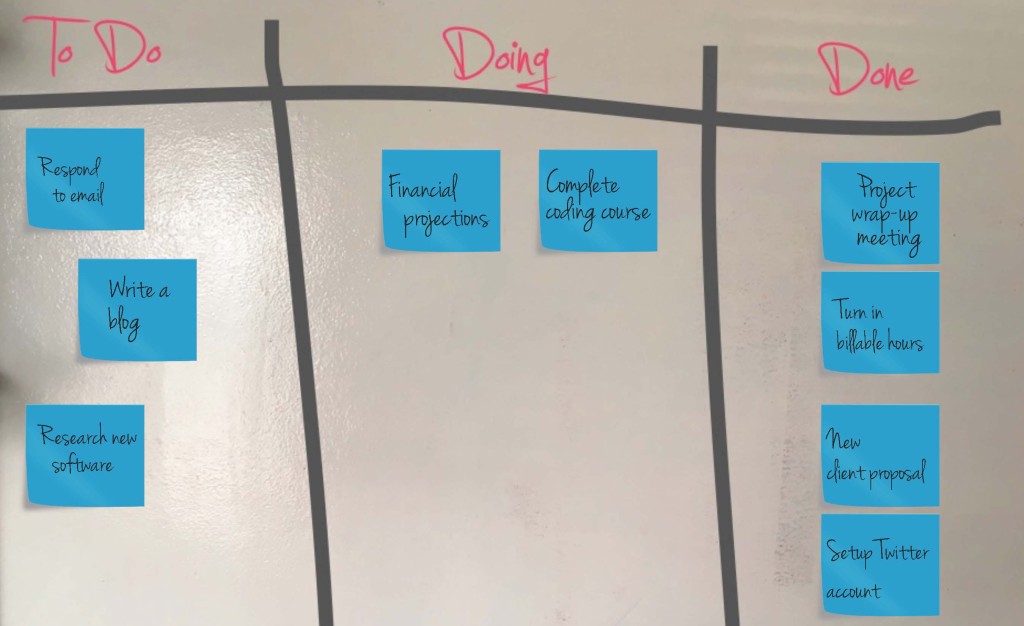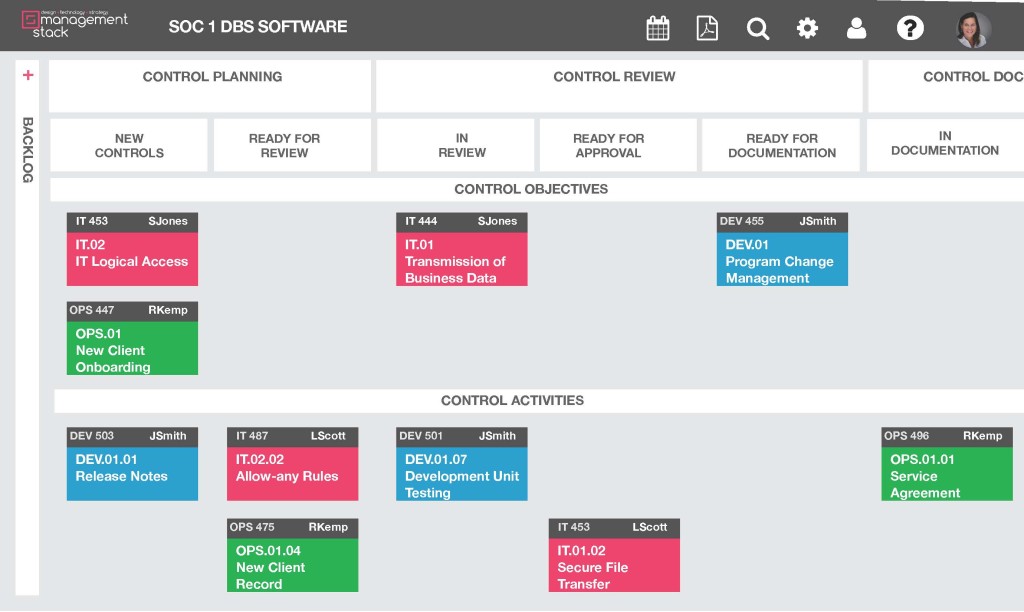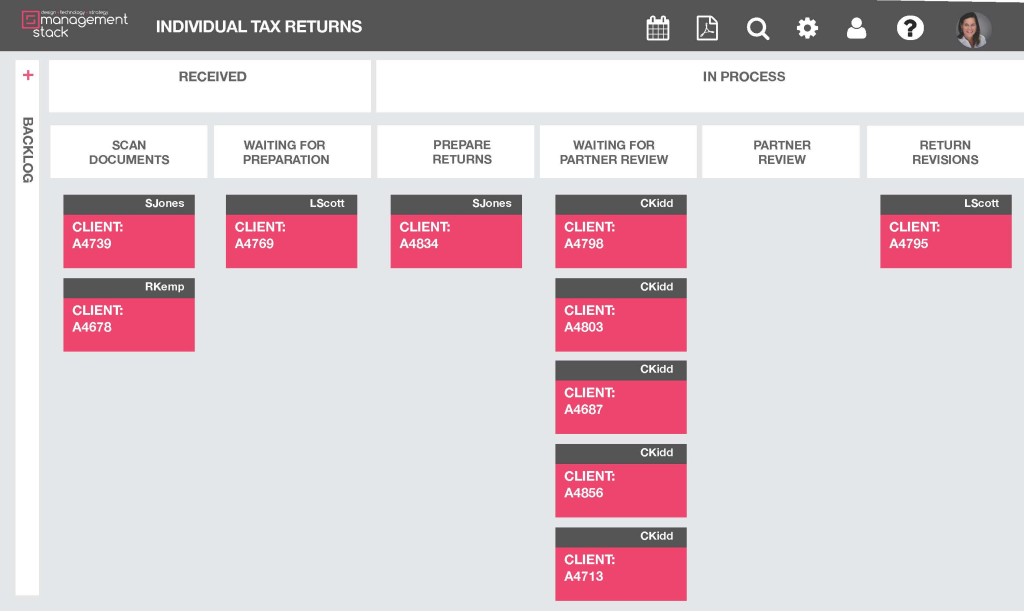
02 Jul Kanban for Accounting Firms
There is little doubt that the rules of business have changed. Because of technology and social media, clients drive business behavior more than ever before in history. Client satisfaction isn’t good enough anymore — client loyalty has become the holy grail of leading indicators to predict future financial performance. And, inefficient and ineffective processes directly affect those client loyalty scores. Clients demand that the job be done completely, on time and correctly the first time, and they can often defect with the click of a mouse if they don’t perceive value in the services provided to them.
Businesses can gain distinct competitive advantages by finding better ways of doing things. Over time, processes can become overly complex to the point that people get lost in their own workflows causing some level of paralysis and inability to move forward. Even firms that have processes that work reasonably well can have a difficult time managing their processes in a way that keeps up with client demands. One way to eliminate most of these organizational problems is to implement a lean methodology called Kanban to increase efficiency, reduce mistakes, identify and correct bottlenecks and communicate progress.
What is Kanban?
In the late 1940s, Taiichi Ohno, an industrial engineer at Toyota, took notice of the way supermarkets managed their inventory. Store clerks restocked shelves based on the store’s inventory, rather than the vendor’s supply. It’s not until supply was running low on the shelves that more inventory was added. Using this just-in-time approach, Ohno developed a Kanban system to match inventory with demand and provide an all-around higher level of quality. Kanban is the Japanese word for “visual card.” At Toyota, workers use Kanban cards to mark steps in their process. When the supply of work is low at one step in the process, a signal is sent to the ‘supplier’ of that process (the preceding step in the workflow) and more work is pulled to ensure just-in-time delivery of components.
Imagine that you work in an office that is always running out of coffee pods before the supply is replenished. Perhaps it is because nobody is notified that the supply is low, or because some people hoard the coffee at their desks. Now, imagine that, in an effort to never be caffeine-less again, you implement a system where the available boxes of coffee pods are stacked up in a central location in the break room, and everyone is instructed that they can only take as many coffee pods as they can consume that day. There is a post-it note stuck to the last box of coffee pods instructing whomever opened that box to take the note to the office manager who then re-orders and stocks the kitchen shelves. You’ve just experienced a simplistic example of a Kanban system.
But Kanban’s applications in the world of knowledge work extend far beyond the break room. Most of us don’t work in silos anymore. Workflows and processes that consist of many people and many steps are woven throughout our workdays. At any given time, an individual may be working on 20 tasks that span many projects. Likewise, a project may have hundreds of tasks assigned to 20 different people. With so many moving parts, it’s no wonder that keeping up with what’s going on with spreadsheets or email isn’t efficient. A Kanban board helps to distribute and prioritize work, communicate to the team and uncover workflow and process problems so that you can continuously improve your processes.
How does Kanban work?
A Kanban board in its simplest form is a visual representation of a ‘to-do’ list that has three columns: to-do, doing and done. You can make a Kanban board for you and/or your team using markers and sticky notes.
Of course, there are also many electronic versions available where you drag and drop “cards” as steps in the workflow are completed. Kanban boards can range from simple to complex, depending on your business needs. You may choose to have high-level boards that give a big picture of what’s going on across the entire company and additional boards for projects or teams.
As a matter of fact, one of the most enticing features of Kanban is that it is doesn’t impose pre-set workflows or processes onto your business. Take, for example, a CPA firm auditing the internal controls of service organizations. The audit team consists of partners, managers and staff accountants. The firm can take their existing workflow and create a Kanban workflow template for each of its projects. When used in a team environment, cards can be assigned to individuals at each step of the way to create accountability for both the audit team and the client. Many virtual Kanban boards will also allow you to attach files to cards so that all of the information and documentation pertaining to the card is in one place and can be retrieved with just a click.
David Anderson, a thought leader in managing effective technology development, is credited with the first implementation of a Kanban process for software development. He identified six general practices and four principles of a successful Kanban implementation.
General practices of Kanban
Visualize the workflow
Marketers typically embrace visual content because 90 percent of information transmitted to the human brain is visual. Not only that, the brain processes visual information 60,000 times faster than text. Kanban takes full advantage of the brain’s visual nature by creating a “picture” of your work. It also helps you see the flow of work as it moves through the Kanban system. Bottlenecks become impossible to ignore because you can actually the see the cards stacking up in one column of the board. For example, tax return preparation is a process that consists of many steps with many people. When a client requests that a firm prepare their taxes, the workflow may look something like this:
Scan documents > Prepare returns > Partner review Return revisions > Partner review > Assemble returns > Partner signature > Client billing > Request client authorization and E-signature > File returns
Following is a sample board showing of the first few steps of the process. A quick glance at the board lets you know immediately that returns are piling up waiting for partner review, causing a bottleneck in the process. Armed with that knowledge, the workflow can immediately be improved, perhaps by replacing the first partner review with a peer review.
Work-in-progress limits
Multitasking kills productivity. Many studies have proven that the more people switch tasks, the less effective and more error-prone they are when completing work. Kanban helps eliminate these context-shifting penalties by limiting work-in-progress. Work is pulled through the system by available capacity, not pushed through based on supply. In other words, people finish what they are working on before starting something new. Increasing efficiency will ultimately reduce the time it takes for an item to travel through the Kanban system.
Manage flow
It’s all about continuous improvement. Kanban systems provide data that allows you to analyze what is flowing through the system. Virtual Kanban tools actually capture data points automatically as cards move through the workflow. Days to complete a task, lead time, wait time, rework time and throughput time all give you valuable information about what incremental changes are needed to improve the flow of work. This data is also predictive in nature, allowing you to forecast future performance.
Make process policies explicit
People working together on a team often incorrectly assume that they have the same ideas about things like project methodology, priorities and communication. And, they often find out about their differences the hard way after losing momentum and cohesiveness in the team. The purpose of explicitly stating process policies is to be sure that everyone knows the “rules of the game.” Once everyone really understands how things work, the team can make decisions that move them in the right direction.
Implement feedback loops
Feedback loops improve productivity. Using feedback loops, you can compare actual outcomes to expected outcomes in order to understand what happened. Feedback should be obtained from the process itself (metrics like cycle time), participants in the process (employees) and customers of the process (clients). Then you can use that information to make iterative improvements to the process.
Improve collaboratively
Kaizen is a word that is often associated with Kanban. Kaizen is another Japanese word that generally means “improvement.” In business, Kaizen is often used to describe a system of continuous improvement, which is a core tenet of Kanban. Further, the Kanban method encourages the use of a scientific approach to implement continuous, incremental and evolutionary changes. For example, you may decide on a new workflow, set an acceptance criteria and define a test period. Then, you try the new workflow during the test period, after which you evaluate the outcome. Finally, you decide to keep or modify the new workflow.
What are the principles of Kanban?
The properties of Kanban describe what you need to do to implement Kanban. There are also four principles to help describe how to think about Kanban.
1. Start with what you know
Implementing Kanban doesn’t require massive changes to your current processes. The point is to start with your current process and then introduce changes based on feedback about the process. Because of the continuous improvement nature of Kanban, the longer you use it, the better your process becomes.
2. Agree to pursue incremental, evolutionary change
Like everything else that we do in business, change is more effective if everyone on the team is on board. Create a culture of continuous improvement by selling team members on the importance of improving the processes. This can be done by showing the team the correlation between better service delivery, customer loyalty and ultimately business success.
3. Respect the current process, roles, responsibilities and job titles
Kanban recognizes that it is likely that there is value in the way things are currently done that should be preserved, so it does not prescribe sweeping changes, which often elicit fear in team members. Explicitly stating that the current processes, roles, responsibilities and job titles are respected will help alleviate fear that often accompanies change and will make team members more comfortable to participate in the smaller improvements along the way. Incremental, rather than sweeping, changes also allow the team to tie results to the change that preceded them which facilitates better decision making.
4. Encourage acts of leadership at all levels of the organization
Team members at all levels need to feel safe to introduce change into the process. There is tremendous value in the perspectives of individuals throughout the organization. Everyone involved, regardless of their pay grade, should feel empowered to show leadership.
Kanban’s usefulness has been recognized in industries like supermarkets, manufacturing and software development, just to name a few. Given the right attitude and culture, a Kanban approach can also help accounting firms.
A Kanban system can help track work being done by providing a visual representation of what has been done, what is being worked on and what still needs to be done. It can also help with the distribution of work. On a Kanban board, work that needs to be done is kept in a backlog column and can be prioritized. Swim lanes can also be added in order to categorize work (e.g. individual vs. business returns) within a single board. When an accountant is done with what they are working on, they can go to the backlog column and pull the next highest priority task that fits within their skill set. Kanban can also help a firm track the resources spent on each client.
Most importantly, Kanban will facilitate continuous process improvement so that firms can give their clients an amazing experience that will keep them coming back for more.
Sources:
- Anderson, David J. “The Principles & General Practices of the Kanban Method.” Lean Kanban Services. Dec. 10, 2010. services.leankanban.com/principles-general-practices-kanban-method
- Wester, Julia. “What is Kanban?” Everyday Kanban. everydaykanban.com/what-is-kanban/



Paula
Posted at 11:07h, 06 SeptemberIt’s great you write about Kanban in terms of accounting practices. It works great in many environments – I know it from marketing, as inspired by this http://kanbantool.com/use-cases/kanban-in-marketing/inbound-marketing text but I’ve seen using it in HR, finance and administrative management too. Worth trying!
Jennifer Eversole
Posted at 11:13h, 06 SeptemberGreat point, Paula. Agile and lean management methods aren’t just for tech companies anymore.
Stephan Erasmus
Posted at 16:39h, 27 OctoberHi, great article. Is there any samples of kanban boards for the different areas of the accounting practice? Like monthly Bookkeeping,
Jennifer Eversole
Posted at 13:49h, 28 OctoberHi Stephan, One of the great things about kanban is that it doesn’t impose pre-set workflows. You can get started by taking your existing workflows and making them visual. As you continue to apply the principles of kanban, your processes will naturally evolve and improve. Good luck!
Mauro Biasolo
Posted at 05:38h, 18 DecemberReally interesting article; let’s see how the accounting world will innovate in the coming years.